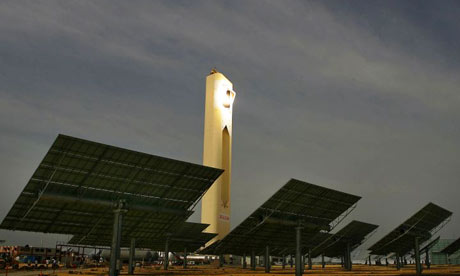
The world’s biggest solar tower will open early this year in Spain. The race for leadership in the next generation of solar power is taking off.
The U.K. Guardian reports that in the desert 20 miles outside Seville, the Spanish company Abengoa will be deploying over 1,000 sun-tracking mirrors — each “about half the size of a tennis court” — to superheat water to 260°C to drive a steam turbine and generate 20MW of electricity.
Concentrated solar power (CSP) technology, as it is known, is seen by many as a simpler, cheaper and more efficient way to harness the sun’s energy than other methods such as photovoltaic (PV) panels.
Spain is placing a huge bet on CSP to meet their renewable energy and carbon targets:
Spanish firms are charging ahead with CSP: more than 50 solar projects around Spain have been approved for construction by the government and, by 2015, the country will generate more than 2GW of power from CSP, comfortably exceeding current national targets. The companies are also exporting their technology to Morocco, Algeria and the US …
The country’s clean energy targets are in line with the EU’s plan to source 20% of primary energy from renewables by 2020, which means that 30% of electricity would have to come from carbon-free sources …
CSP projects across Spain are built with the promise that the government will pay a premium, known as a feed-in tariff, for any CSP electricity sent into the grid. The PS20 is part of a €1.2bn series of solar power plants based on CSP technologies including tower plants and trough-style collectors — where water is passed in tubes directly in front of parabolic mirrors that collect sunlight — and a few PV panels planned by Abengoa. The solar farm will eventually generate up to 300MW of power, enough for the 700,000 people of Seville, by 2013.
The ultimate goal is to add thermal storage to CSP and create what I think is more accurately called solar thermal baseload:
The 20MW solar tower is also a forerunner for an even more ambitious idea, one that Abascal [Abengoa’s CTO] hopes will become a standard for CSP plants in future — a 50MW version that could generate electricity around the clock. “During the day, you’d use 50% of your electricity to produce electricity and 50% to heat molten salt. During the night you use the molten salt to produce electricity.”
Molten salt technology is in its early stages but Abengoa is testing the idea at a power plant in Granada. So far the company has demonstrated that it is possible to store up to eight hours of solar energy by heating tanks containing 28,000 tonnes of salt to more than 220C. “This will make it possible to have almost constant production or at least it will be able to produce energy for most of the day,” said Abascal.
Kudos to Spain for leading the way on this crucial climate solution.
This post was created for ClimateProgress.org, a project of the Center for American Progress Action Fund.


